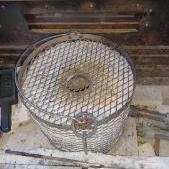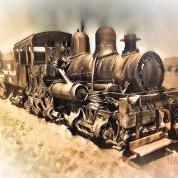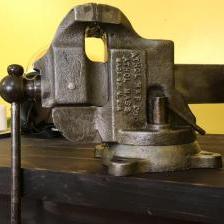-
Posts
77 -
Joined
-
Last visited
Profile Information
-
Gender
Not Telling
-
Location
Pittsboro, NC
-
Interests
photography, Art Deco, stainless steel
Converted
-
Location
Pittsboro, NC
-
Interests
photography
-
Occupation
PHB
Recent Profile Visitors
-
IronAlchemy started following Beginner anvil question , Holes in the Bottom of my Copper Ingots , buying cheap supplies (rivets) and 7 others
-

Holes in the Bottom of my Copper Ingots
IronAlchemy replied to King_JRB's topic in Smelting, Melting, Foundry, and Casting
In principle, that is a sensible answer George. However, boiling point of copper is 4643F and has a fairly low vapor pressure at temperatures below the melting point of iron which I am sure was not exceeded here. Caveat - I do not cast copper but I am a chemist so do understand something of the issues. Consider this a [guess]. Oxygen is quite soluble in copper (up to about 1%). From the look of the ingot, you could well be seeing outgassing at the center where it looks as if you are pouring the molten metal. The oxygen would form a gas as the metal cools in this region forming the bubbles that you see in the ingot. You could consider pouring at a lower temperature which would mean less oxygen in solution and having the mold hotter for slower cooling to allow the gas to escape more effectively. From the look of the ingot, the metal cools pretty rapidly on contact with the mold. Also consider how you pour to minimize the contact of the copper with air. Commercially, I think that they use phosphorus or lithium as a deoxidizer to avoid this issue. Let us know how it progresses. -

buying cheap supplies (rivets)
IronAlchemy replied to Duckkisser's topic in Blacksmithing, General Discussion
I cannot say that I have done a price comparison but for many years I have bought rivets from Jaycee Sales (rivetsonline.com). They have a pretty wide selection of metals (brass, copper, steel, stainless, monel, aluminum) and a wide size selection. I have also used their pop rivets. -

Re-shim a Clay Spencer tire Hammer
IronAlchemy replied to eidilon's topic in Power Hammers, Treadle Hammers, Olivers
I am not an expert but did build one and have used it quite a bit. I have never had to adjust my shims so I checked the manual. You should have the same number of shims on each side of the ram if possible. Install as many shims as you can and still raise the ram in the guide. Typically there are two shims on one side of the ram and three on the other for each axis. If you have binding of the shims and they are slipping out, perhaps they are too tight or not kept oiled well enough. Maybe there is debris on the ram that is causing friction. You might want to double check the geometry of your clips if the shims are slipping past them. If you find the magic fix, please post back so we all can learn. -
I have cut hundreds of blanks of this size on annealed S7 on my portaband. If hardened, an abrasive cutoff wheel works fine. Waterjet sounds like major overkill and *very* expensive. Losing a single blade testing on the portaband will likely be a small fraction of the setup charge on a water jet.
-
For books, go to bluemoonpress.com and search repousse. I am not familiar with European artists or training opportunities but in the US you can check out Doug Pryor (http://douglaspryor.com) and Saign Charlestein (http://www.saignc.com) as current artists who also teach. Saign sells tools as well. Ernie Dorrill used to teach but has pretty much retired. Dan Nauman, Tom Latane, Peter Renzetti and Carl Close are also well know US blacksmiths who do chasing and repousse in iron. There are numerous other artists that you can find online.
-
I truly appreciate your reply to my Iron Kiss info request. I would really like to know how to properly do the routine maintenance and adjustments.
I was only able to use it for a short time before having to disconnect it and move to a new shop. I haven’t hooked it back up yet. Every once in a while it would stick at the top.
Let me know what I owe you for your time and effort.
Gary Cremeens
-

Iron Kiss airhammer maintenance info needed
IronAlchemy replied to firebug's topic in Power Hammers, Treadle Hammers, Olivers
I have the manual for my 100lb Ironkiss. Each hammer came with a manual specifically for that hammer since John Larson often made ongoing improvements and changes. Maintenance should be similar. Contact me with a personal message if you want a copy of my manual and I will scan it in. -

Annealing and passivating stainless steel
IronAlchemy replied to blaksdc's topic in Heat Treating, general discussion
For the kind of items you are making, no additional treatment is typically needed to maintain corrosion resistance. The main issue you may have is if you use a non-stainless wire brush on your items that can transfer iron onto the surface. This can lead to more surface rust though much less than on a mild steel item. It is true that if you passivate with (preferably) citric acid or nitric acid, you will change the as-forged look. I have items forged without further treatment and used outside for 15 years that are rust free or with only a few specks of rust on them. They still look pretty much the same as when I first finished them. -
Sad to see a good tool crack. I have had a lengthwise quench failure in a hammer exactly like this when I quenched 4140 in water. It may well be that the quench was too aggressive. When you heat a quench oil, it reduces the viscosity and greatly accelerates the convective stage of the quench. Contrary to intuition, hot oil typically quenches more aggressively than cold oil.
-

Does Ferric Chloride Freeze Well?
IronAlchemy replied to BlackburnRose's topic in Alchemy and Formulas
Speaking as a chemist and not someone who has actually tested this, ferric chloride should freeze and thaw without damage. That said, you need to have it in a container that will not break when the liquid expands on freezing. The active etching from ferric chloride comes from hydrochloric acid released in the solution. It just does not maintain as high a concentration of acid as you can get with pure HCl. -

Beginner anvil question
IronAlchemy replied to masonred's topic in Anvils, Swage Blocks, and Mandrels
Brian's anvil design is for use with a striker. They are intentionally made from mild steel so that they are soft when struck by missed blows and can easily be dressed when abused. They are mounted lower than a conventional anvil to allow for the height of top tooling over a hardie tool. They are not really for general use. -
Usually I use the forge (gas or coal) to heat the struck end but it makes no difference how you do it. Torch does work fine.
-
Like Thomas says, S7 works great for hot working tools especially for something like slitting where the tool can get very hot. It is also really good for tools used cold when the edge is left at a hard temper. All my chasing tools are S7 for example. S7 generally heat treats easily because of the air hardening. As mentioned, it does not normalize. It needs to be heated to 1750F (typically described as cherry). When heating from cold for forging or heat treatment, don't heat it too fast. Heat it gradually or it can develop cracks from that. Folks preferences vary but I like to harden the whole tool as you did since the struck end will mushroom if left fully annealed. I think it most likely that the problem you had was that you only tempered the cutting edge whereas you hardened the whole tool. This left everything but the edge fully hardened and brittle. Also when you temper S7, it takes a quite high temperature to reduce the hardness. I temper the struck end to at least 1000F which is about where you just see color in the metal which would leave it near Rc 50 which is still pretty hard. Straw color is typically about 450F in carbon steels which would leave your edge at ~Rc 55. That said, alloy steels do not exhibit the same temper colors as carbon steel. I have dozens of S7 tools forged without heat treating in an oven and have yet to have a failure so it is generally pretty forgiving.
-
I have a #58 with the side shelf and I use the shelf frequently. I kept the edges on the shelf a bit sharper than the anvil edges so they are useful for forging a sharp inside corner. Also it is useful for straightening with the piece bridging between the anvil surface and the shelf much as you might do across the hardie hole. I really like the gradual curved transition from the anvil face to the horn on the #58. It gives me a whole new set of curves readily at hand. I moved from a London pattern anvil and the only thing that I occasionally miss is the step. I make up for that with a hardie tool that gives close to the same functionality.
-
There is an article where Peter Ross shows how to hand forge this part out of iron if you would rather go that way. Bronze I am sure would work but I have never seen one out of bronze. http://www.anvilmag.com/smith/107f2.htm Regs, Doug




